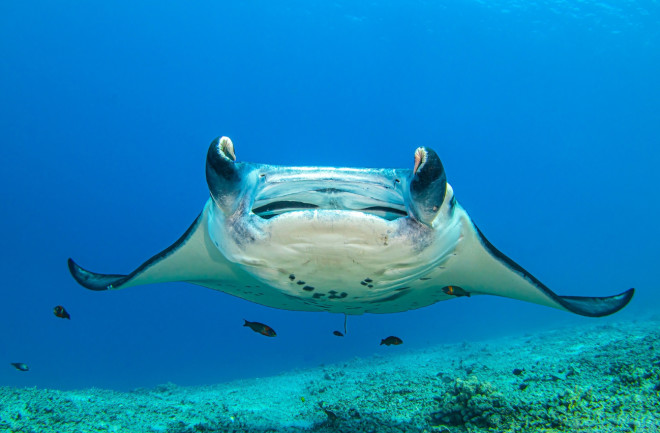Edy Setyawan, a marine researcher in Raja Ampat, Indonesia, has spent nearly a decade researching manta rays. But he remembers one in particular: a baby that had gone “toe-to-toe” with a shark and was left with a brutal bite on its wing.
The baby defended itself with its wing, Setyawan says, knowing that this is one of the few parts of its body that can recover from such an injury. The fact that even a pup knew how to survive in such a situation, he continues, is proof that these gentle giants are among the smartest fish in the ocean.
How Big Are Manta Rays?
The giant manta ray is the largest ray in the ocean, with a wingspan of up to 30 feet. It’s a slow-growing, long-lived species that has been shown in some cases to live up to 60 years, says Setyawan.
Much of his observations occur in what are called “cleaning stations.” Manta rays often hover over coral reefs while cleaner fish, like the wrasse fish and the scarlet cleaner shrimp, remove parasites, dead skin cells and bacteria from the rays’ skin.
Although manta rays tend to fly solo, they’re known to gather at such cleaning sites during certain times of the day. In the morning or afternoon, for example, they regularly find their spot on the coral reef and enjoy what basically amounts to a marine spa treatment.
As the tiny fish and crustaceans clean the rays, Setyawan bears witness to a sea creature in its element. “It’s the best place to interact with mantas,” he says.
Read More: Startling New Sea Creatures
Are Manta Rays Dangerous?
One day, a mature female manta ray allowed Setyawan to approach and make close eye contact from just a foot away. While the creatures abhor being touched and usually leave immediately if they feel uncomfortable, in this case, Setyawan was allowed to stare deeply into her eyes.
It was almost as if she trusted him: “It was a cool experience,” he says.
Most of Setyawan’s interactions, however, come from babies that are inquisitive even at birth. “Baby mantas have never seen a human, so the first time they’re curious,” he says.
They often circle around the researchers for nearly 30 minutes just after birth, in fact. Unlike whales, manta babies are independent from the moment they enter the world, ready to explore and quickly learn the necessary tools for survival.
Read More: Why Do Sharks Attack Humans?
Where Do Manta Rays Live?
Manta moms give birth to around one live pup every two to three years, and then she sets them on their way. Scientists think that the animals give birth in manta ray nurseries, where most of the mantas living there are pups.
Setyawan says he and his colleagues have found the world’s first confirmed manta ray nursery in Raja Ampat. In this protected environment, the babies are birthed and live until large enough to survive elsewhere.
“It took eight years of research to prove we had found it,” he says. His findings were published in May 2022 in Frontiers in Marine Science.
Manta rays’ large brain-to-body ratio allows them to have individual personalities, says Setyawan. His team can tell them apart from the unique spot patterns on their bellies. “It’s like their fingerprint,” he says.
Some are shy and some are more extroverted. Some are ready and willing to show off their bellies and identify themselves, while others swim in the other direction. “They’re smart, almost like the dolphins of fish,” says Setyawan.
Read More: Reefs Are So Damaged That Fish Have Begun to Use Each Other As Cover
Are Manta Rays Endangered?
While their population size isn’t entirely known, research indicates that between 16,000 and 20,000 manta rays live in the wild — distributed prevalently in places like the Maldives, Raja Ampat and Mozambique.
Due in part to their low birth rates, however, the gentle giants are uniquely vulnerable to declines. The population throughout much of the world, in fact, has seen declines due to fisheries — where they’re trapped as bycatch in fishing nets.
Yet they’ve also been known to survive and thrive in places like Raja Ampat, where net fishing is banned and ocean sanctuaries abound. For Setyawan, manta rays have much to offer and teach us about the oceans that they call home. It would be such a shame, he says, to lose that knowledge.
Read More: Why Is the Elusive Colossal Squid So Hard to Come Across?

